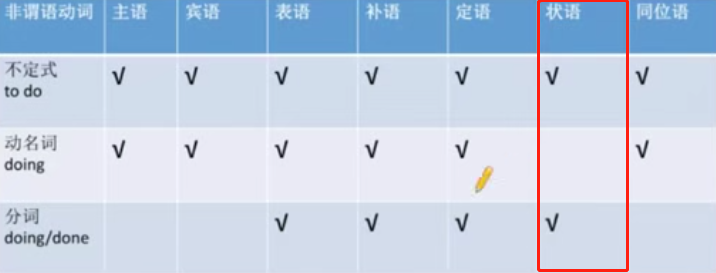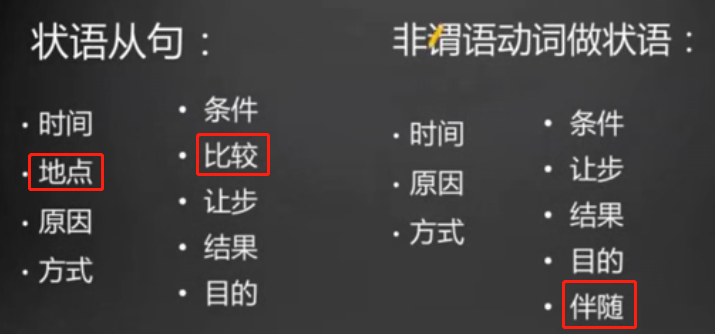耿建超英语语法---非谓语动词作状语
 1 非谓语动词作状语
1 非谓语动词作状语
对比状语从句来记忆:

2 不定式作状语
(1)不定式作目的状语(to ,in order to(为了) ,so as to (这样))
举例:
- 我是来看你的---i came here to see you.
- 为了能赶上第一班公车,他起的很早---in order to catch the first bus,he got up very early.
- 他弯下腰去捡笔---he bent down so as to pick up the pen.
(2)不定式作原因状语(to)
一般都是主系表结构,且表语是人的情绪。举例:见到你我很开心---i am glad to see you.
(3)不定式作结果状语
- to 这位年轻人非常愿意帮助我---this young man is very pleasure to help me.
- so..as to/such...as to(太...以至于...)
你能行行好借我点钱吗---could you please be so kind as to lend me some money.
你能行行好借我点钱吗---could you please be such kind man as to lend me some money.
- only to(有点惊讶,译为“结果却是”) 我要开门,却发现门是锁住了---i am going to open the door only to find it was locked inside.
- too...to(太...以至于不能...) 他太年轻了以至于不能上学---he is too young to go to school.
- enough...to(足够的) 他很勇敢,敢在晚上一个人出门---he is brave enough to go out alone at night.
3 分词作状语
再讲每个具体的状语之前,首先介绍一点细节:
- 用分词作状语时,要首先判断是主动还是被动
- 当表示有明显的先后顺序且是主动的时候,用“having done”;当表示有明显的先后顺序且是被动的时候,用“having been done”。
- 否定直接在分词前加“not”
(1)分词作时间状语
- 用了很长时间之后,这本书显得很旧---used it for a long time,the book looked very old.
- 用这本书的时候,我发现它很有用---using this book , i found it was very useful.
第二句也可以这样表述:when using this book , i found it was very useful.这是因为分词既可以用作时间状语,也可以用作其他状语,加上连接词能更加具体一点,上边两种表述都是正确的。
(2)分词作原因状语
- 没有地方去,那个人就在街上闲逛---having no place to go ,that man wandered on the street.
(3)分词作条件状语
- 多给点时间,他就能做的更好---given more time , he can do it better.
(4)分词作让步状语
- 那么努力工作,他还是失败了---working so hard , he failed.
(5)分词作结果状语
- 他回家很晚,让他的爸爸很生气---he got home late making his father angry.
(6)分词作方式状语
- 他看着窗外,好像在思考---he is looking through window,as if thinking.(不加上连词还能理解成伴随状语,加上就具体了)
(7)分词作伴随状语
- 他进来了,后面跟着他的女儿---he came in followed by his daught.
- 老师跟着学生进来了---the teacher came in following students.


 浙公网安备 33010602011771号
浙公网安备 33010602011771号